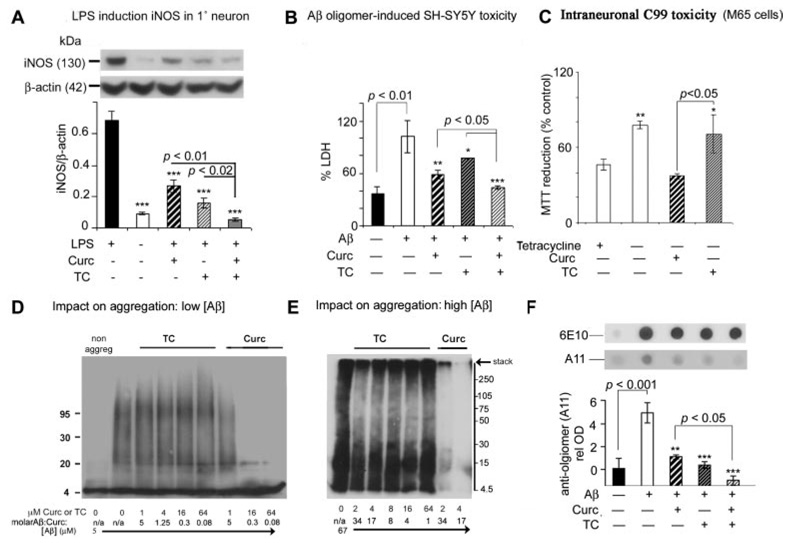Fig. 10.
Differential impact of TC versus curcumin on iNOS, Aβ toxicity and Aβ aggregation in vitro. Primary cortical neuron cultures (A) or the microglial cell line BV-2 (data not shown) were treated with 1 µg/ml LPS, and iNOS protein levels in the detergent-soluble fraction were measured by Western blot with or without curcumin (2.5 µM), TC (2.5 µM), and curcumin + TC (1.25 µM each), using β-actin as an endogenous control to ensure equal protein loading. LPS induction of iNOS was attenuated by curcumin (50%), TC (80%), or combined curcumin + TC (95%). B, attenuation of Aβ42 oligomer (500 nM)-induced toxicity (% maximal LDH) in SH-SY5Y neuroblastoma by pretreatment with curcumin (40%), TC (20%), or curcumin + TC (70%). C, TC, but not curcumin minimized the reduction in viability [3-(4,5-dimethylthiazol-2-yl)-2,5-diphenyltetrazolium reduction] in MC65 neuroblastoma cells caused by intraneuronal expression of C99, 3 days after tetracycline withdrawal. D and E, Western blot for Aβ immunoreactivity bands (6E10) to assess drug effect on aggregation of specific molecular weight oligomers. Impact of cotreatment of TC and curcumin on aggregation of low-dose (5 µM) Aβ (D) or high-dose (67 µM) Aβ (E), initially monomerized with HFIP. F, both TC and curcumin reduced levels of oligomeric-specific antibody A11 during oligomerization of 11 µM Aβ, using starting curcuminoid/Aβ molar ratio of 1.45 to 1. Equal loading is demonstrated by a second dot blot with 6E10. Values shown are the mean ± S.D. *, p < 0.05; **, p < 0.01; and ***, p < 0.001 represent significant differences compared with positive control (n = 4) and treatments (n = 4).

